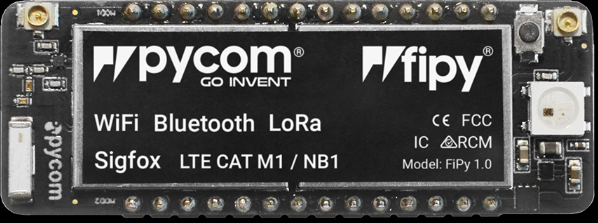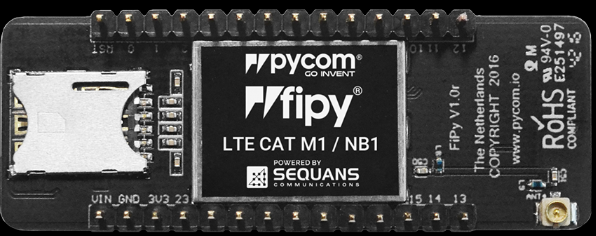 Loading... Please wait...
Loading... Please wait...Currency Displayed in
Categories
FiPy
Product Description
FiPy
 Top
Top
 Bottom
Bottom
(Above pictures not to scale)
Imagine 5 networks in one perfectly-formed, same-small-foot-print-as-WiPy- LoPy-and SiPy, IoT development board. MicroPython enabled. Featuring WiFi, Bluetooth, LoRa, Sigfox and dual LTE-M (CAT M1 and NBIoT) the FiPy gives access to all the world’s LPWAN networks on one tiny board.
NOTE: An LTE Antenna MUST always be used with LTE CAT M1 / NB1, or it could cause serious damage to the development board.
To get all the information you will ever need on this module please go to the Pycom website for this product
FiPy Features
– Powerful CPU
– Five networks: WiFi, BLE, cellular LTE-CAT M1/NB1, LoRa and Sigfox
– 1KM WiFi range
– MicroPython enabled
– Fits in a standard breadboard (with headers)
– Ultra-low power usage: a fraction compared to other connected microcontrollers
Processing
– Espressif ESP32 SoC
– Dual processor and WiFi radio system on chip
– Networking processor handles the WiFi connectivity and the IPv6 stack
– Main processor is entirely free to run the user application
– An extra ULP-coprocessor that can monitor GPIOs, the ADC channels and control most of the internal peripherals during deep-sleep mode while only consuming 25uA
Interfaces
– 2 x UART, 2 x SPI, I2C, micro SD card
– ANalog channels: 8×12 bit ADCs, 2×8 bit DAC
– Timers: 2×64 bit with PWM with up to 16 channels
– DMA on all peripherals
– GPIO: Up to 22
Hash / Encryption
SHA, MD5, DES, AES
WiFi Networking
802.11b/b/n 16mbps
Bluetooth
Low energy and classic
RTC
Running at 32KHz
Range
Node range: Up to 50km
Security & Certifications
– SSL/TLS support up to 1.2
– WPA Enterprise security
– AES encryption engine
Memory
– RAM: 4MB
– Flash Memory: 8MB
– GPIO: Up to 22
– Hardware floating point acceleration
– Python multi-threading
Power
– Voltage Input: 3.3V – 5.5V
– 3v3 output capable of sourcing up to 400mA
Sigfox Operating Frequencies
RCZ1 – 868MHz(Europe)
RCZ2 – 902MHz (US, Canada and Mexico)
RCZ3 – (Japan and Korea)
RCZ4 – 920-922MHz (ANZ, Latin America and S-E Asia)
Sigfox Specification
– TI CC1125NarrowbandTransceiver
– Class 0 device. Maximum Tx power:
- – +14dBm (Europe)
- – +22dBm (America)
- – +22dBm (Australia and New Zealand)
– Node range: Up to 50km
– Sigfox pre-certified (October 2016)
– Power
- – Sigfox (Europe): 17mA in Rx mode, 47mA in Tx mode and 0.5uA in standby
- – Sigfox (Australia, New Zealand and South America):
- 24mA in rX mode, 257 mA in Tx mode and 0.5uA in standby
Bluetooth Networking
– Low energy and classic
– Compliant with Bluetooth v4.2 BR/EDR and BLE specification
– Class-1, Class-2 and Class-3 transmitter without external power amplifer
– Enhanced power control
– +10dBm transmitting power
– NZIF receiver with -98 dBm sensitivity
– Adaptive Frequency Hopping (AFH)
– Standard HCI based on SDIO/SPI/UART
– High speed UART HCI, up to 4 Mbps
– BT 4.2 controller and host stack
– Service Discover Protocol (SDP)
– General Access Profile (GAP)
– Security Manage Protocol (SMP)
– Bluetooth Low Energy (BLE)
– ATT/GATT
– HID
– All GATT-based profile supported
– SPP-Like GATT-based profile
-BLE Beacon
-A2DP/AVRCP/SPP, HSP/HFP, RFCOMM
– CVSD and SBC for audio codec
– Bluetooth Piconet and Scatternet
LoRa Operating Frequencies
– 868MHz(Europe) at +14dBm maximum
– 915MHz (North and South America, Australia and New Zealand) at +20dBm maximum
LoRa Specification
– Power consumption: 10mA Rx, 28mA Tx
– LoRaWAN stack – Class A and C devices
– Node range: Up to 40km
– Nano-gateway: Up to 22km (Capacity up to 100 nodes)
LTE-M Operating Frequencies
– 34 bands supports from 699Mhz to 2170Mhz (Total world-wide support)
LTE-M Specification
– One single chip for both CAT M1 and NB1 (yes, only one chip)
– 3GPP release 13 LTE Advanced Pro
– Supports narrowband LTE UE categories M1/NB1
– Integrated baseband, RF, RAM memory and power management
– Reduced Tx power class option
– Peak power estimations: TX current = 420mA peak @1.5Watt RX current = 330mA peak @1.2Watt
– Data rates:
- – 300 kbps DL
- – 375 kbps UL (LTE Cat M1 in 1.4 Mhz, HD-FDD)
- – 40 kbps DL
- – 55 kbps UL (LTE Cat M2 in 200 kHz, HD-FDD)
Tx/Rx Frequencies
| Ports for LTE Bands | Tx frequencies | Rx frequencies |
| Low bands 5, 8, 12, 13, 18, 19, 20, 28 | 699 to 915 MHz | 729 to 960 MHz |
| Mid bands 1, 2, 3, 4 | 1710 to 1980MHz | 1805 to 2170 MHz |
WiFi Networking
– Up to 1km range
– 802.11b/g/n 16mbps
– Power: 12mA in active mode, 5uA in standby
Size
55m x 20mm x 3.5mm (Without Headers)
Weight
– 7g
– 31g (Packaged)








